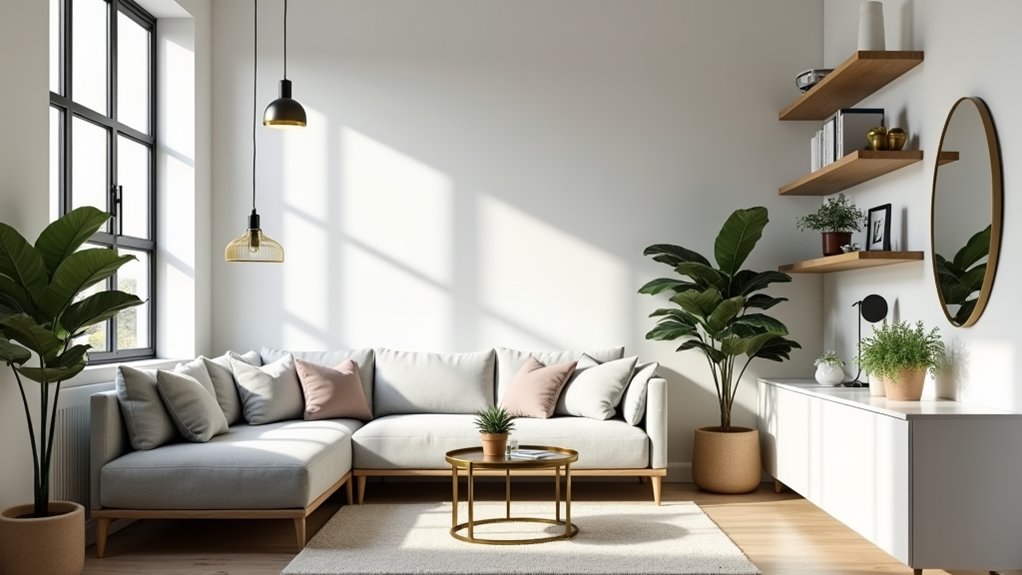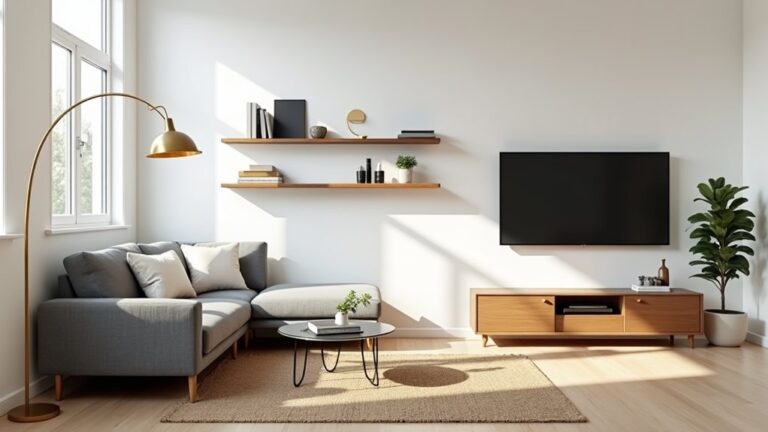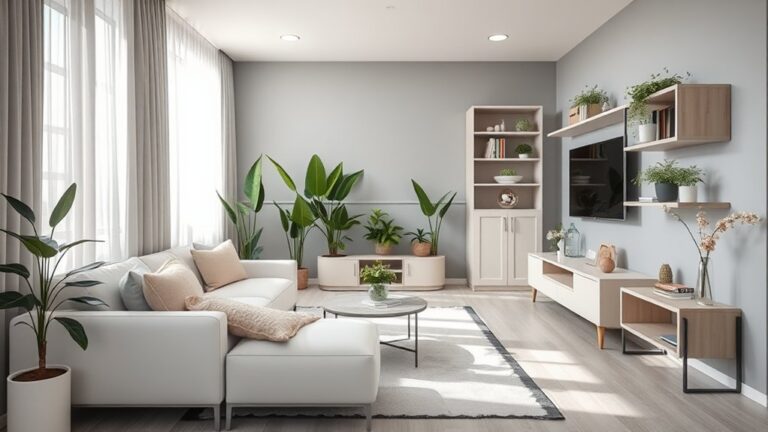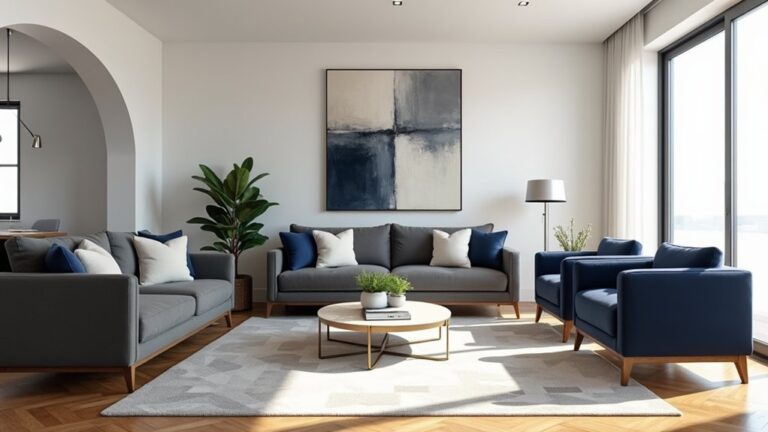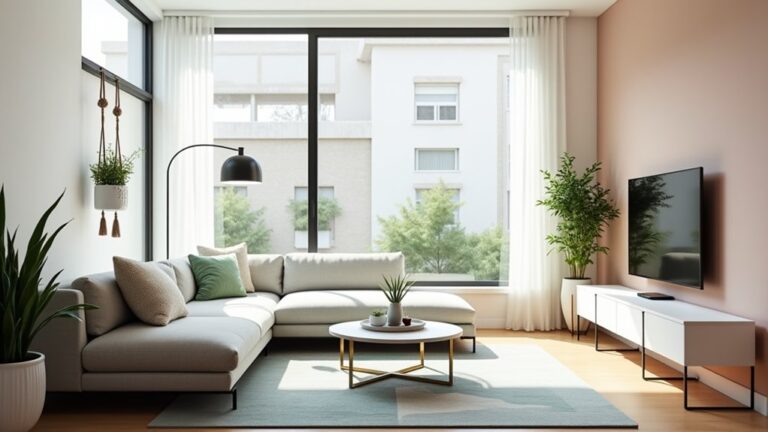Smart design solutions for small living rooms focus on maximizing every inch of space through strategic choices. Multi-functional furniture pieces, like storage ottomans and lift-top coffee tables, serve dual purposes while maintaining style. Vertical space optimization using wall-mounted shelving and lighting keeps floor areas open and clutter-free. A neutral color palette with selective accent colors creates an airy atmosphere, while mirrors and layered lighting enhance brightness and depth. Clear pathways and floating furniture arrangements guarantee comfortable flow throughout the space. These foundational principles reveal endless possibilities for transforming compact spaces into sophisticated, functional sanctuaries.
Key Takeaways
- Choose multi-functional furniture like storage ottomans and lift-top coffee tables to maximize space while maintaining style.
- Keep furniture arrangements floating away from walls and maintain clear pathways for better flow and openness.
- Incorporate vertical storage solutions with wall-mounted shelves and lighting to free up floor space.
- Use neutral colors as a base with strategic accent colors to create depth without overwhelming small spaces.
- Utilize mirrors and natural light while layering artificial lighting at different heights to enhance spatial perception.
Maximize Space With Strategic Furniture
When it comes to small living rooms, furniture selection and placement can make the difference between a cramped space and a comfortable, functional one.
Choose multi-functional pieces like ottoman storage or fold-down tables. Strategic furniture arrangement is key – float seating away from walls, use slim profiles, and maintain clear pathways.
Room decor should emphasize vertical space while keeping floor areas open.
Solid wood furniture proves to be a worthy long-term investment due to its exceptional durability and timeless appeal.
Utilize Vertical Space Effectively

Making the most of vertical space opens up endless possibilities in compact living rooms.
Install high shelves near the ceiling to store books and decorative items while drawing the eye upward, creating an illusion of height.
Opt for wall-mounted lighting fixtures or slim floor lamps instead of table lamps to free up surface space.
Consider vertical panel artwork to emphasize room height.
Incorporating wall-mounted organizers helps maintain visual clarity while keeping essentials accessible and maximizing floor space.
Smart Storage Solutions
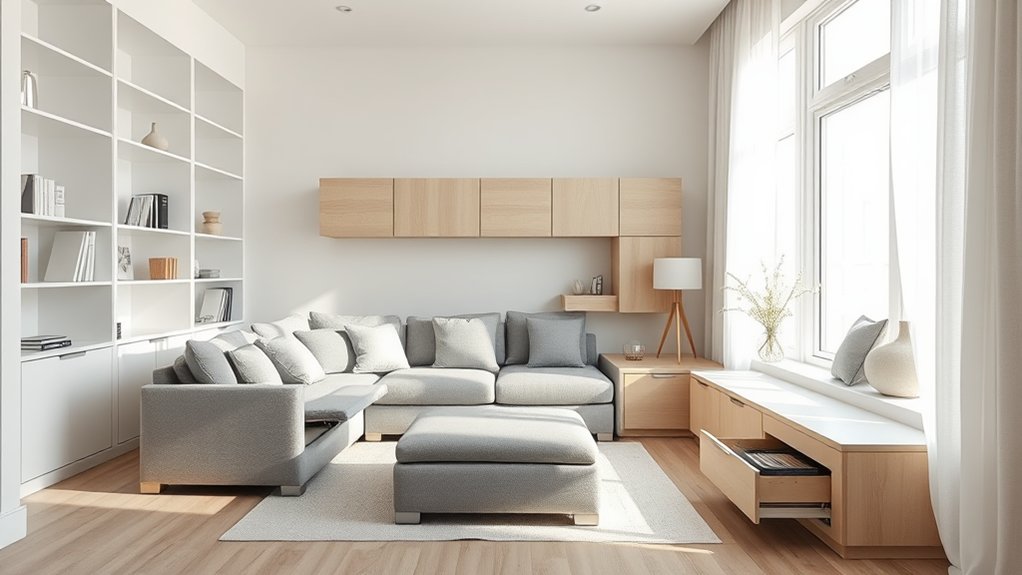
Maximizing storage in a small living room requires creative furniture choices that serve multiple purposes while maintaining visual appeal. Hidden storage ottomans, lift-top coffee tables, and console cabinets offer elegant solutions for concealing everyday items without compromising style. Incorporating wall-mounted shelving units and floating cabinets creates additional storage opportunities while preserving valuable floor space. Following small space minimalism principles helps maintain a clutter-free and serene environment.
Hidden Storage Furniture Pieces
Smart storage solutions begin with strategically chosen furniture pieces that conceal everyday items while maintaining a polished aesthetic.
Consider ottomans with hidden compartments for blankets, coffee tables featuring secret shelves beneath lift-top surfaces, and bench seating with internal storage.
Modern entertainment units with sliding panels and multi-functional side tables with concealed drawers maximize space while preserving visual harmony.
Vertical Storage Ideas
Your vertical wall space represents prime real estate for clever storage solutions in a small living room.
Install floating high shelves near the ceiling to display books and decorative items while maximizing floor space.
Consider tall, narrow storage cabinets that extend upward rather than outward, and incorporate wall-mounted organizers behind doors to conceal everyday items while maintaining visual harmony.
Double-Duty Wall Solutions
Modern wall solutions can serve multiple purposes in a small living room, combining functionality with aesthetic appeal.
Consider installing decorative shelves that double as art displays while providing storage space.
Wall decor can incorporate hidden compartments for electronics or fold-down surfaces for temporary work areas.
These dual-purpose elements maximize space efficiency without compromising style or visual harmony.
Perfect Color Schemes
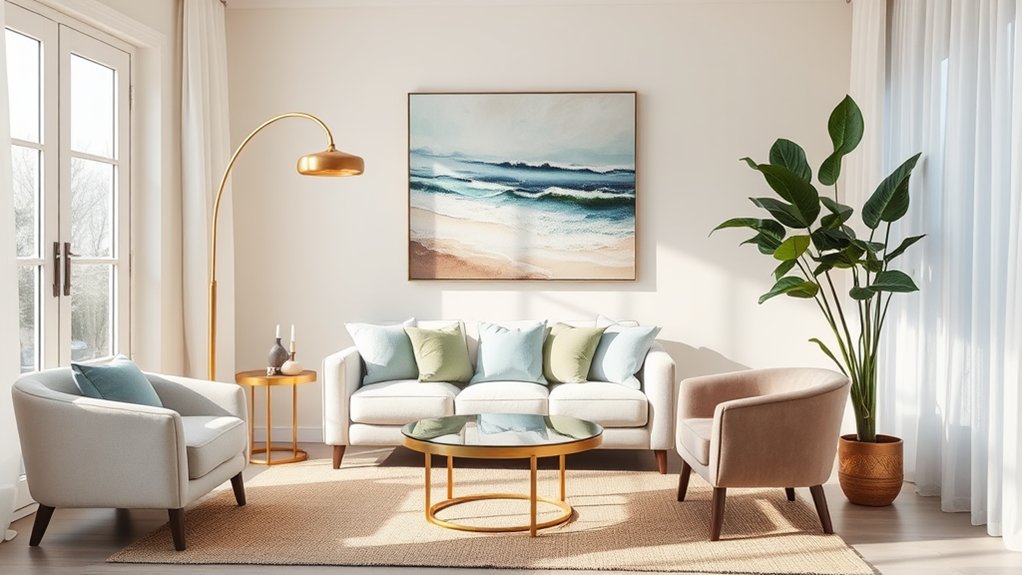
Selecting the right color scheme stands as one of the most powerful ways to transform a small living room into an inviting, spacious-feeling sanctuary.
While color trends come and go, a palette built around neutral tones creates an expansive atmosphere.
Opt for soft whites, warm beiges, or cool grays as your base, then layer in accent colors strategically to add depth without overwhelming the space.
Mirrors and Lighting Placement
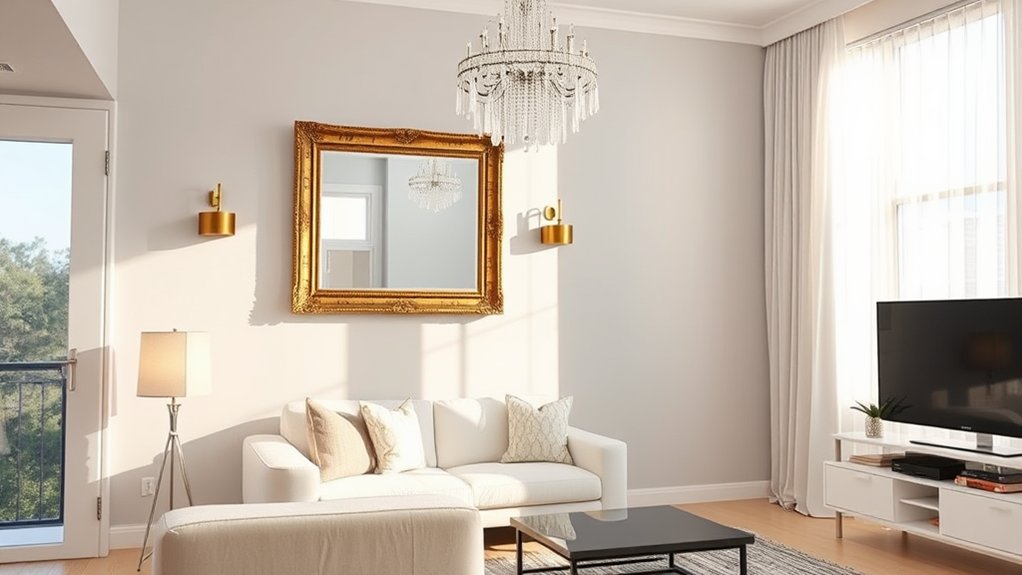
Smart placement of mirrors and lighting works in tandem to create the illusion of expanded space in compact living rooms.
Position large mirrors opposite windows to maximize natural light reflection, while integrating wall decor strategically around them.
Layer artificial lighting at different heights, and keep window treatments minimal.
Mirrors placed near light sources multiply brightness and depth, making the room feel substantially larger.
Double-Duty Furniture Ideas
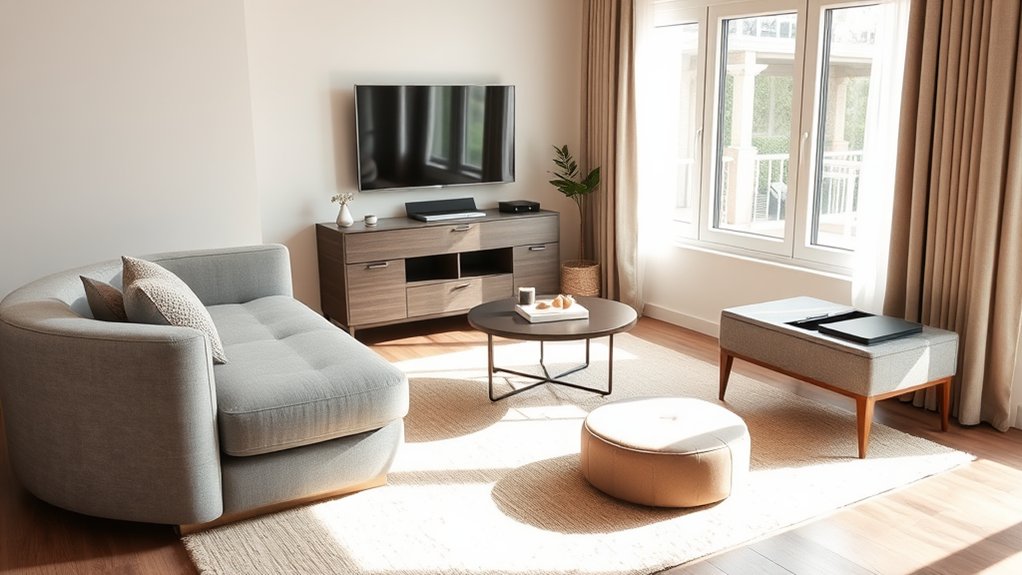
For small living rooms, double-duty furniture serves as a game-changing solution that maximizes both space and functionality.
Current furniture trends favor ottomans with hidden storage, expandable coffee tables that transform into dining surfaces, and sleeper sofas that accommodate overnight guests.
Modern room decor embraces murphy beds with integrated desks and modular seating units that reconfigure based on specific needs.
Create Visual Flow
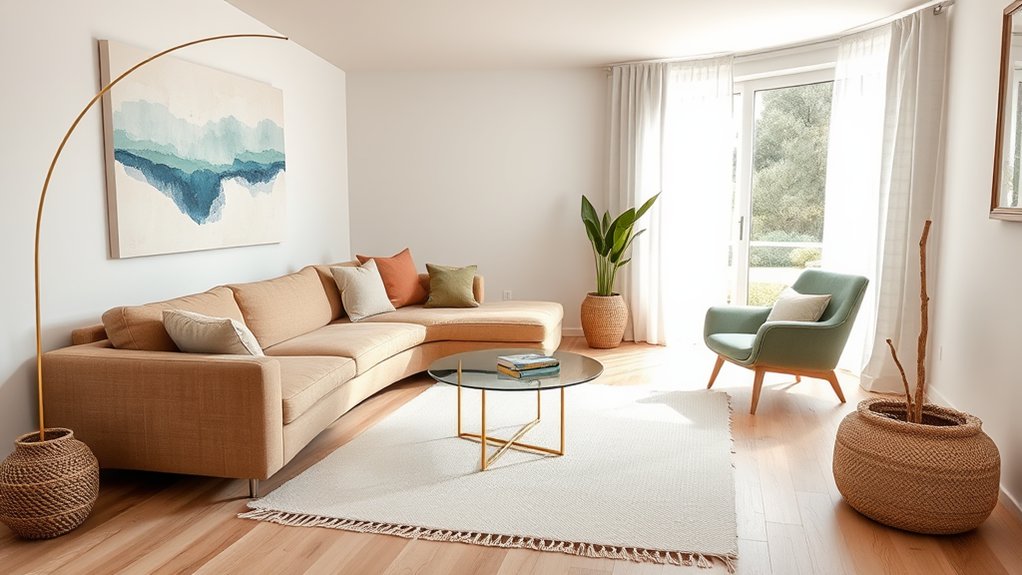
Creating visual flow in a small living room begins with establishing a clear pathway that guides movement naturally through the space.
Strategic furniture placement along the walls can craft an intuitive circulation pattern while maximizing the room's central area for comfortable navigation.
The flow should connect key architectural features, particularly from doorways to windows, allowing both foot traffic and sight lines to move effortlessly through the space.
Path Around the Room
A well-designed traffic flow through your living room serves as an invisible guide, directing movement while maximizing the functionality of your space.
When planning your room layout, maintain a clear pathway of at least 30 inches between furniture pieces. Position larger items against walls, and guarantee the traffic flow naturally leads to key focal points and doorways without creating obstacles.
Strategic Furniture Placement
Strategic placement of furniture sets the foundation for a visually harmonious living room, building upon the established traffic patterns.
Position larger pieces like sofas against walls to maximize space, while arranging smaller elements to create conversation areas.
Select room decor and furniture style that maintain proportional balance, keeping sightlines open and avoiding the temptation to overcrowd the space.
Doorway to Window Flow
Natural movement through your small living room should flow seamlessly from doorways to windows, creating an instinctive pathway that draws the eye through the space.
Arrange furniture to establish clear walking paths, and keep window treatments minimal to maximize natural lighting.
Position larger pieces along walls rather than blocking circulation routes, allowing the room to breathe and function efficiently.
Frequently Asked Questions
How Do I Arrange Multiple Area Rugs in a Small Living Room?
Layer smaller rugs strategically, ensuring proper rug placement aligns with your room layout. Position them at different angles, using varied sizes and complementary patterns to define distinct functional zones.
What's the Ideal TV Viewing Distance for a Compact Living Space?
Like finding the sweet spot in a concert hall, ideal TV viewing requires positioning your seat at 1.5-2.5 times the screen size, maintaining a 30-degree viewing angle for comfortable, immersive entertainment.
How Can I Soundproof My Small Living Room From Neighboring Spaces?
Install soundproofing materials within walls and use decorative acoustic panels strategically. Double-pane windows, heavy curtains, and plush area rugs effectively absorb sound while maintaining an elegant, well-designed aesthetic.
Should I Match My Curtains to the Wall Color or Furniture?
Picture a harmonious watercolor palette: Curtains can either blend with walls for seamless flow or complement furniture colors. Consider fabric selection and color coordination to create visual interest while maintaining design balance.
Can Indoor Plants Thrive in a Small Living Room With Limited Sunlight?
Many low-light tolerant plants like snake plants, pothos, and ZZ plants can thrive indoors with minimal natural lighting. Position them near windows and supplement with grow lights for ideal plant care.
Conclusion
Small spaces ironically offer the grandest opportunities for design innovation. While compact living rooms initially appear limiting, strategic furniture placement, vertical storage, and thoughtful color schemes transform spatial constraints into aesthetic advantages. Through clever mirror placement, multifunctional pieces, and calculated lighting, these rooms become masterworks of efficiency. The true art lies in creating an expansive visual flow that defies physical boundaries, proving that limitations often spark the most elegant solutions.

